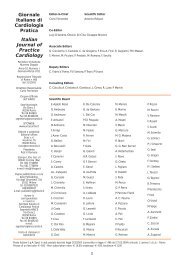Scarica il documento in formato pdf (574 KB - ANCE
Scarica il documento in formato pdf (574 KB - ANCE
Scarica il documento in formato pdf (574 KB - ANCE
Create successful ePaper yourself
Turn your PDF publications into a flip-book with our unique Google optimized e-Paper software.
Risk prediction <strong>in</strong> heart surgery:<br />
mortality rate and complications<br />
Predizione del rischio <strong>in</strong> cardiochirurgia:<br />
dalla mortalità alle complicazioni<br />
*P. P<strong>in</strong>na P<strong>in</strong>tor, **M. Bobbio, **S. Colangelo<br />
Da due decenni è cresciuto l’<strong>in</strong>teresse della comunità scientifica dei medici e chirurghi sulla predizione dei rischi,<br />
specialmente per quanto riguarda le malattie cardiovascolari e i tumori. Oggigiorno i pazienti, i cardiologi, i cardiochirurghi,<br />
gli amm<strong>in</strong>istratori degli ospedali e delle assicurazioni sono <strong>in</strong>teressati a conoscere <strong>il</strong> rischio operatorio, generalmente<br />
<strong>in</strong>teso come “rischio di mortalità”. La mortalità totale (crude), <strong>in</strong>tesa come la percentuale di pazienti deceduti sul numero<br />
degli operati, non considera <strong>il</strong> rischio connesso alle condizioni preoperatorie di ciascun paziente. Per l’attribuzione<br />
del rischio di mortalità, è necessario pertanto stratificare i pazienti <strong>in</strong> base a modelli statistici di predizione derivati<br />
selezionando i fattori associati significativamente al rischio di mortalità. Gli studi più recenti concordano sull’aumento<br />
graduale del rischio di mortalità dei pazienti sottoposti a by-pass aorto-coronarico (BPAC) negli ultimi 10 anni. Nel<br />
frattempo la mortalità per BPAC isolato è progressivamente dim<strong>in</strong>uita e la durata della degenza <strong>in</strong> terapia <strong>in</strong>tensiva<br />
(ICU-LOS), è andata progressivamente aumentando tra <strong>il</strong> 1991 e <strong>il</strong> 1999. Inoltre, per i pazienti con un aumento della<br />
ICU-LOS aumenta anche <strong>il</strong> rischio di mortalità ed <strong>il</strong> consumo di risorse. Considerando <strong>il</strong> pesante fardello che un<br />
prolungamento della ICU-LOS può avere sulle decisioni cl<strong>in</strong>iche, organizzative ed economiche, è ragionevole sv<strong>il</strong>uppare<br />
ricerche tese a comparare modelli già validati, verificando quali sono più accurati nel predire <strong>il</strong> prolungamento<br />
dell’ICU-LOS, e a sensib<strong>il</strong>izzare gli operatori sull’opportunità di identificare quei pazienti che, per l’alto rischio, sono<br />
più adatti al trattamento medico o all’angioplastica.<br />
Dur<strong>in</strong>g the last two decades the <strong>in</strong>terest of the scientific medical and surgical community regard<strong>in</strong>g the prediction of risks<br />
is risen, especially as to cardiovascular diseases and tumours. Nowadays patients, cardiologists, cardiac surgeons, hospital<br />
and <strong>in</strong>surance managers are <strong>in</strong>terested to know the operat<strong>in</strong>g risk, generally understood like “mortality risk”. Crude<br />
mortality does not take <strong>in</strong>to account the preoperative condition of the patients. So it is necessary to stratify patients<br />
accord<strong>in</strong>g to risk stratification models that have been developed select<strong>in</strong>g the factors significantly associated with mortality<br />
risk. Current data have proved that the average mortality risk of patients undergo<strong>in</strong>g CABG has been gradually <strong>in</strong>creas<strong>in</strong>g<br />
for at least 20 years, wh<strong>il</strong>e the mortality for isolated CABG surgery decreased progressively. At the same time the length<br />
of stay <strong>in</strong> the <strong>in</strong>tensive care unit (ICU-LOS) progressively <strong>in</strong>creased, because of a particularly low rate of survival of high<br />
risk patients; the prolongation of the ICU-LOS <strong>in</strong>volves a remarkable <strong>in</strong>crease <strong>in</strong> costs per s<strong>in</strong>gle hospitalisation and a<br />
disproportionately high use of reanimation beds. Consider<strong>in</strong>g the heavy burden that prolonged ICU-LOS st<strong>il</strong>l can have <strong>in</strong><br />
cl<strong>in</strong>ical, organisational, and economical decisions, it is reasonable to carry out researches aimed to compare already<br />
validated models, check<strong>in</strong>g the ones which are more accurate <strong>in</strong> predict<strong>in</strong>g the prolongation of ICU-LOS. This strategy<br />
would sensitise field operators’ awareness on the issue of proper <strong>in</strong>tervention <strong>in</strong>dications and on the opportunity of<br />
identify<strong>in</strong>g those patients for whom an <strong>in</strong>tervention is not to be recommended and to whom alternate treatment, medical<br />
or angioplasty, should be suggested.<br />
(It J Practice Cardiol 2003;1:7-16)<br />
Key words: cardiac surgery • complications • costs • risk model • ICU stay<br />
© 2003 <strong>ANCE</strong> Ricevuto <strong>il</strong> 16 apr<strong>il</strong>e 2003; accettato <strong>il</strong> 10 giugno 2003.<br />
*MD PhD, Cardiologist, President of the A.P.P. Fondation Via Vespucci 61 - Tor<strong>in</strong>o, Italy<br />
**MD, Director Heart Fa<strong>il</strong>ure Unit - University Department of Cardiology - San Giovanni Hospital - Corso Dogliotti 14 -<br />
10126 Tor<strong>in</strong>o, Italy<br />
**MD, Cardiology Fellow<br />
Correspond<strong>in</strong>g author: P. P<strong>in</strong>na P<strong>in</strong>tor<br />
Tel. 011 5802365, Fax 011 5683893, E-ma<strong>il</strong> fondazione@p<strong>in</strong>nap<strong>in</strong>tor.it<br />
It J Practice Cardiol is ava<strong>il</strong>able at http://www.ancecardio.it<br />
7
















